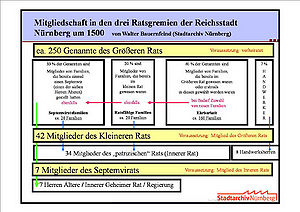
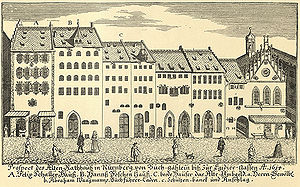
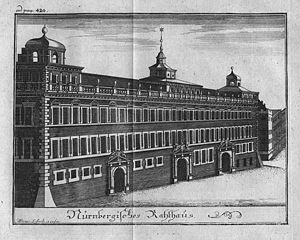
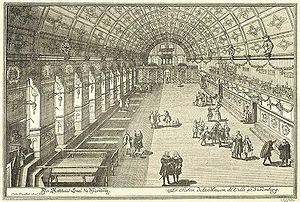
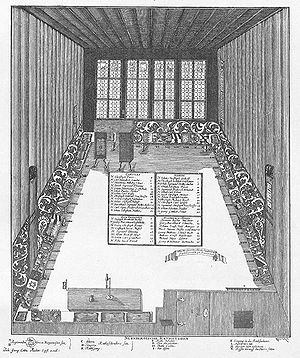
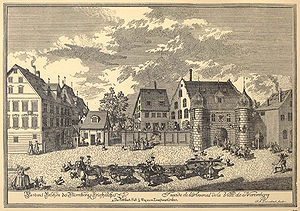
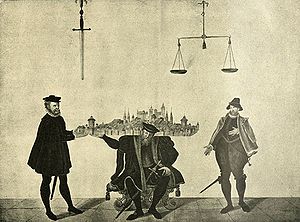
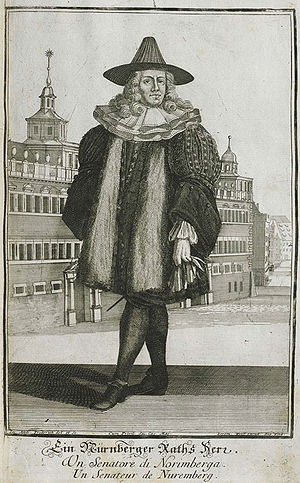
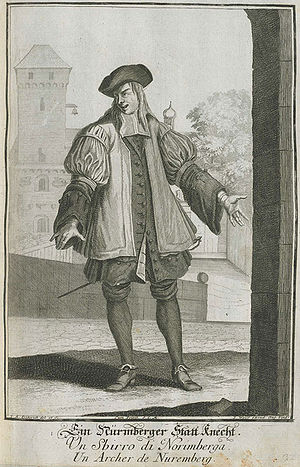
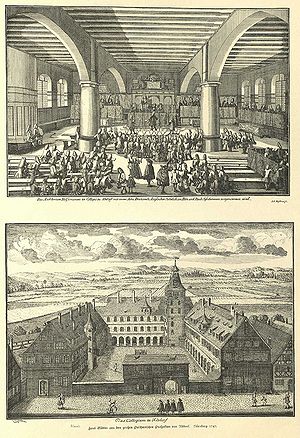
The fortunes of the Imperial City of Nuremberg were controlled by the patriciate until 1794. It was dominant on the Council, which is first attested to in 1256 and which developed into the Inner or Lesser Council in the course of the late Middle Ages. The septemvirate emerged from the Lesser Council as the actual government, headed by a triumvirate of three Supreme Chiefs. By contrast, the Greater Council, which was established in the early 14th century, had little importance and was only able to gain more influence from 1794 onwards. Nuclei of larger municipal authorities were the "Ratskanzlei" (Council Chancellery) for the Judiciary, the "Losungsamt" (Tax Office) for the Financial Administration and the Construction Office. During the 16th century, other central authorities were added for special tasks and the administration of the land territory.
The rise of the Council
In the Late Middle Ages and Early modern times, Nuremberg was a large city of European rank, which called itself a "republic" . It was governed, as pointed out in 1516 by the Council lawyer Christoph II Scheurl (1481-1542), who had been involved in the revision of the Nuremberg city law since 1514, by a circle of politically entitled families who exclusively occupied all council seats and council offices. The script by Scheurl, addressed to Johannes von Staupitz (1465-1524), Vicar General of the Reformed Augustinian Eremites and a supporter of Martin Luthers (1483-1546), is a condensed description and therefore one of the extremely rare surviving insights into the Nuremberg Council government, which had been used shortly thereafter by Emperor Karl V (ruled the Empire 1519-1556, died 1558) as a model for the constitutions of the Upper German imperial cities.
The politically entitled families, referred to as the patriciate since the period of humanism, first appeared as an independent council in 1256. Since the end of the 13th century, it had consisted of two councils responsible for judicial and administrative matters respectively. Both were made up of 13 members each. The judicial council of the "scabini" (jurors) was presided over by the "Reichsschultheiß" (Imperial bailiff). The more important council, however, was formed by the "consules"; they were able to lay claim to all the newly emerging tasks in the 14th century. The two councils merged around 1320 to form the Council, often referred to as the Lesser Council in contrast to the Greater Council.
This process was accompanied by the gradual disempowerment of the Reichsschultheiß, whose office was increasingly restricted to high justice tasks. Since 1313 he was sworn to the council, in 1339 his office was given to a citizen by way of a pledge, in 1385 the town acquired the pledge and finally in 1427 the whole office. From then on, the Reichsschultheiß was a municipal official responsible for representative and military duties and his court functions were transferred to the municipal court. From 1571 onwards, the office of the Reichsschultheiß was combined with that of the Vorderster Losunger (the highest official office).
The Craftsmen’s Uprising 1348/49 came with a short interruption in the patrician city government. As a result, the Lesser Council gained another 16 members in 1370. As a concession to the craftsmen, the mightiest population group – at least in terms of numbers – one representative of each of the eight most respected trades was admitted to the Council, but they were denied an arbitrative role in the city government. At the same time as the craftsmen though, another eight members of the patrician families, the so called "Alten Genannten" (Old Nominated), were inducted into the Council. The overall government or the rule of the authorities in executive, legislative and jurisdiction matters in the imperial city and later in the extended land territory was assigned solely and exclusively to the patrician Lesser Council, which was later also called the magistrate. From 1370, it was composed of 34 patrician councillors and the eight "friends of the council from the trades". The members from the patriciate provided the 26 mayors and the eight Alte Genannte. The 26 mayors were divided into 13 “elder” and 13 “younger” mayors, who had been called this since 1392 and who ruled in pairs for four weeks each ("Frager"), with the elder mayor presiding over the Council meetings and the younger one presiding over the court.
A committee was formed within the council by the seven “elder gentlemen”. They came from the ranks of the elder mayors, and, as the "Inner Privy Council" or "Collegium Septemvirale", constituted the actual executive authority in the city-state, which handled all affairs of state. At their top, and therefore at the head of the imperial city administration, was a triumvirate of the three “foremost councillors”, who held the title of “Real Imperial Councillor” after 1721. The triumvirate, who also acted as Supreme Chiefs, was in charge of all offices in the city and the land territory. Together they watched over the relics and the Imperial Regalia. The two head councillors or the Vorderster Losunger managed the city's finances. The elder councillor or Vorderster Losunger was also entrusted with the ”Sekretin” (secret) seal of the Imperial City, and from 1571, he also held the office of Reichsschultheiß and was the keeper of the Imperial Castle. The remaining four men in the septemvirate were behind the three supreme captains in the curriculum honorum and had no formalized functions.
The Greater Council
In the course of the 14th and 15th centuries, a group of honourable citizens, who were appointed as legal witnesses, joined the patrician Council in the cities’ administration. These 300 to 500 appointees formed the Greater Council, which only met very rarely. While it was still relatively frequently listed as a participatory body in laws and ordinances in the first half of the 14th century, in the following centuries its activities were mainly limited to its judicial function and convening at the annual council elections. Additional elections to the Greater Council were carried out by the Lesser Council as required. Otherwise, the Greater Council was only summoned by them in crisis situations in order to obtain a broader basis for their decisions. It was only in the last years of the imperial city that the Greater Council was able to gain more political weight and push through a revised constitution in the Basic Treaty of 1794, which gave it important powers.
Authority apparatus
While the complicated structure of the Council still reveals a system of collegial order, the authorities showcase a confusing coexistence of offices and functions. The Nuremberg administration had grown from the medieval conditions unaltered, with the result that over the centuries, separate offices or new Council Deputations were created for all areas of public life and for all new tasks and functions that the state had accrued, especially since the introduction of the Reformation.
The nuclei of larger imperial city authorities were the "Losungamt", the "Ratskanzlei" and the Construction Office. The "Losungamt", known as the "Losungstube" until the 17th century, was the imperial city's most distinguished authority. A direct wealth tax for special financing purposes, known as the "Losung", was collected from the citizens of Nuremberg probably as early as the 13th century. This tax was made permanent during the 14th century and amounted to 1% (2% since 1758). The administration of these funds was the responsibility of the Vorderster Losunger, the holder of the highest office in the imperial city hierarchy. The Losungsamt not only collected and administered this tax in the city but also drew up the city's accounts. The Losungsamt was also the place where the privileges of the imperial city were kept and the archive was located, where major regulatory work was carried out from the 15th century onwards.
The Ratskanzlei was the hub of the Lesser Council's business. Led by two chancellery clerks from the circle of the seven elder gentlemen, their staff consisted of council clerks, chancellery clerks and registrars. A separate Ratskanzlei registry is documented from the 15th century at the latest.
It can be assumed that since the late 13th century the city had its own imperial city construction organisation which was responsible for the city's extensive construction programme. From the 14th century, the supervision of this work was the responsibility of a Lesser Council deputation under the leadership of one of the Supreme Chiefs. In the 14th century, the actual management was carried out by four master builders, combined into one master builder in the 1390s, who was a member of the Lesser Council as an "Alter Genannter". The construction office was responsible for the imperial city's construction industry, for paths and footbridges, for the Pegnitz and partly also for the building trades. A separate building authority registry exists since the beginning of the 16th century.
In addition to these three administrative areas, other central authorities developed during the state expansion of the Early modern period to cope with new tasks in the 16th century:
- The "Landpflegamt" (Land Office) for the administration of the land territory (in particular the Neue Landschaft (new territory) acquired in 1504/05)
- The "Kriegsamt" (War Office) and the “Zeugamt" (Arsenal) for military administration
- The "Scholarchat" (Education Office) with the supervision of the church, school, education and partly the poor. It was also in charge of the supervision of the imperial city's University of Altdorf.
In the second half of the 18th century, the political leadership, jurisdiction, military sovereignty, church, school and social services, police, financial and economic management in the imperial city, as well as the administration of the land territory, were distributed among 24 central offices and 95 Council Deputations, in which the overlapping of departments could not be avoided in many cases.
Dominance of the patricians in leading positions
All the leading positions in these deputations and Council offices were filled by the 34 patrician members of the Lesser Council, who, in a multiple accumulation of offices, had all the hubs of power firmly in their grip and dealt with all the decisive issues on the collegial Council until the Basic Treaty of 1794. While this ensured mutual control, it made it practically impossible to take any individual initiative or make rapid decisions. Moreover, since the second half of the 16th century, the strict observance of hierarchy and career by years of service meant that the most important offices were only attainable at an advanced age. Added to this was the exclusive restriction to the patrician families, which in the course of the Early modern period had to lead to an inevitable standstill, contributing - among many other factors - to the decline of the imperial city.
The constitutional reform of 1794
Due to the imperial city's precarious financial situation and under the pressure of the merchants who wanted to participate in the city government, an immediate constitutional revision was carried out in 1794. The city constitution was also officially put into written form for the first time in the so-called Basic Treaty. In addition to the Lesser Council, a 17-member committee (7 patricians, the 4 market provosts and 2 other merchants, 3 master craftsmen and the bourgeois council lawyer) was now formed by men from the Greater Council, which was limited to 250 people, with 70 patricians, merchants and craftsmen, 20 scholars and civil servants each. From then on, the Greater Council had a right of approval in all tax matters and had to be consulted on all matters concerning treaties, sales of state assets and borrowing.
The unclear demarcation of responsibilities among the Lesser Council, the Greater Council and the Committee led to reciprocal political blockades in the following period. An imperial sub-delegation commission set up in 1797 finally disempowered the Lesser Council. It was now independently responsible for foreign policy only, while the sub-delegation took its place in internal affairs. They simplified the structure of the authorities, abolished numerous special administrations and almost all deputations, dismantled the old collegial central authorities of the Losungamt, Landpflegamt and Kriegsamt by 1805, created new modern central authorities in the form of the Exchequer, the Territorial Office and the Police Department, and in 1805 also reformed the Lesser Council, which now formed a magistrate consisting of 27 patrician and 8 bourgeois senators under the chairmanship of 3 Council directors for 4 months each.
This structure was abolished after 15 September 1806 by the new Bavarian state administration.
References
- Andrea Bendlage/Peter Schuster, Hüter der Ordnung. Bürger, Rat und Polizei in Nürnberg im 15. und 16. Jahrhundert, in: Mitteilungen des Vereins für Geschichte der Stadt Nürnberg 82 (1995), 37-55.
- Rudolf Endres, Grundzüge der Verfassung der Reichsstadt Nürnberg, in: Zeitschrift der Savigny-Stiftung für Rechtsgeschichte, Germanistische Abteilung 111 (1994), 405-421.
- Peter Fleischmann, Rat und Patriziat in Nürnberg. Die Herrschaft der Ratsgeschlechter in der Reichsstadt Nürnberg vom 13. bis zum 18. Jahrhundert. 3 Bände (Nürnberger Forschungen 31), Nürnberg 2008. [dort ausführliche Bibliographie und Quellennachweise zu Rat und Patriziat]
- Heinrich Dannenbauer, Die Entstehung des Territoriums der Reichsstadt Nürnberg, Stuttgart 1928.
- Michael Diefenbacher/Rudolf Endres (Hg.), Stadtlexikon Nürnberg, Nürnberg 2. Auflage 2000.
- Werner Schultheiß, Altnürnberger Rechtspflege, in: Mitteilungen des Vereins für Geschichte der Stadt Nürnberg 61 (1974), 188-203.
- Helge Weingärtner, Die Selbstverwaltung der Reichsstadt Nürnberg, in: Michael Diefenbacher/Gerhard Rechter (Hg.), Vom Adler zum Löwen. Die Region Nürnberg wird bayerisch 1775-1835 (Ausstellungskataloge des Stadtarchivs Nürnberg 17), Nürnberg 2006, 29-42.
Further Research
External Links
Related Articles
- Nürnberg, Reichsstadt: Handel
- Nuremberg, Imperial City: Political and social development
- Nuremberg, Imperial City: Territory
- Nürnberg, Reichsstadt: Handwerk
- Städtische Gerichtsbarkeit
Cite
Michael Diefenbacher, Nuremberg, Imperial City: Administration, published 09 March 2010, English version published 06 March 2024; in: Historisches Lexikon Bayerns, URL: <https://www.historisches-lexikon-bayerns.de/Lexikon/EN:Nuremberg,_Imperial_City:_Administration> (20.12.2025)
